Organisation Behaviour Report: Primark, Leadership and Management
VerifiedAdded on 2023/01/13
|18
|6396
|83
Report
AI Summary
This report provides a comprehensive analysis of organizational behavior, focusing on the application of relevant theories and concepts within the context of Primark. It begins with an introduction to organizational behavior and its impact on employee performance, followed by an examination of the influence of organizational culture, power dynamics, and politics on individual and staff behavior. The report then evaluates process and content theories of motivation, exploring how these theories can be applied to improve employee engagement and productivity. Furthermore, the report delves into the factors that contribute to effective and ineffective teams, offering insights into team dynamics and collaboration. Finally, the report concludes by applying organizational behavior concepts and philosophies to the case of Primark, providing practical recommendations for enhancing organizational effectiveness and leadership. The report draws on various theories and research to support its analysis, offering a well-rounded perspective on the subject.
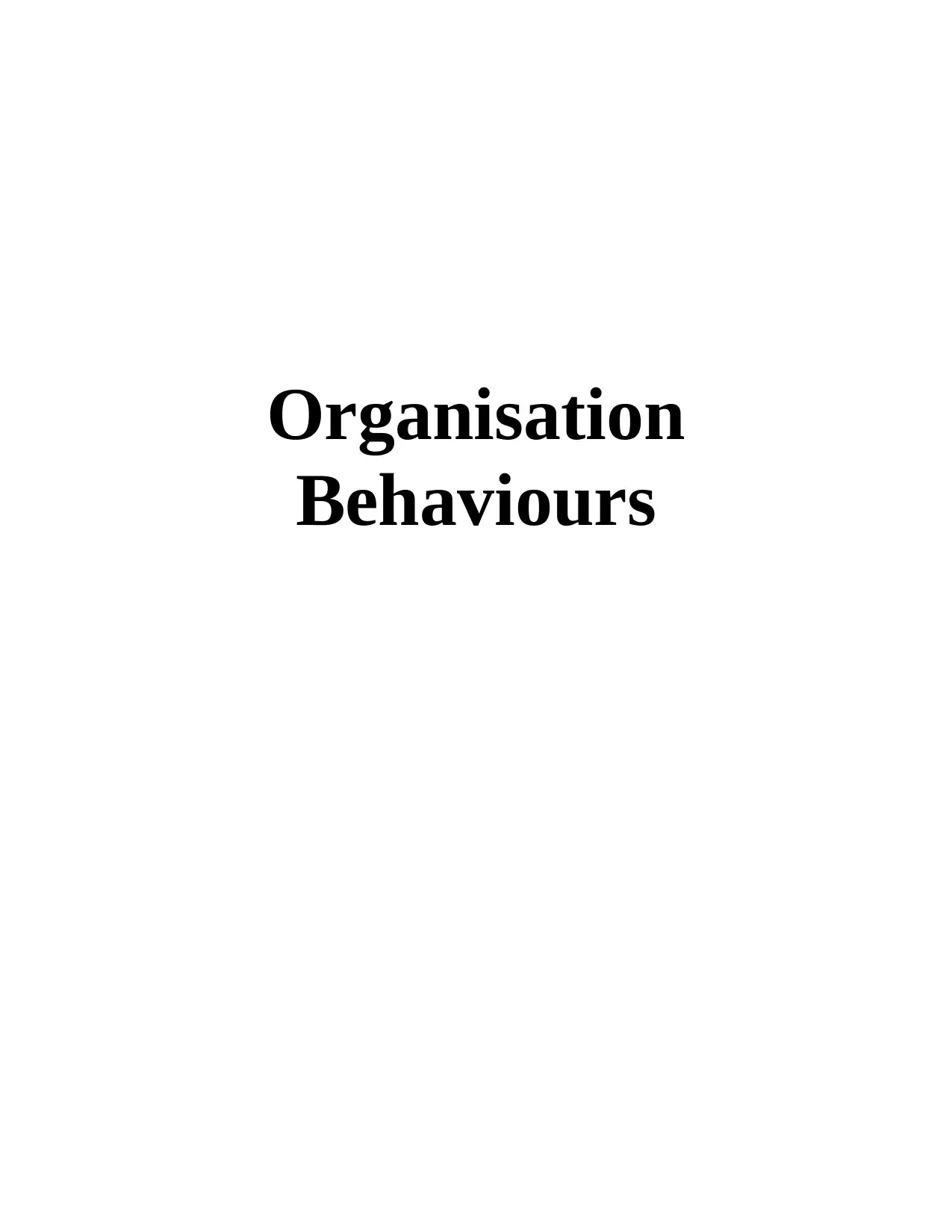
Organisation
Behaviours
Behaviours
Paraphrase This Document
Need a fresh take? Get an instant paraphrase of this document with our AI Paraphraser
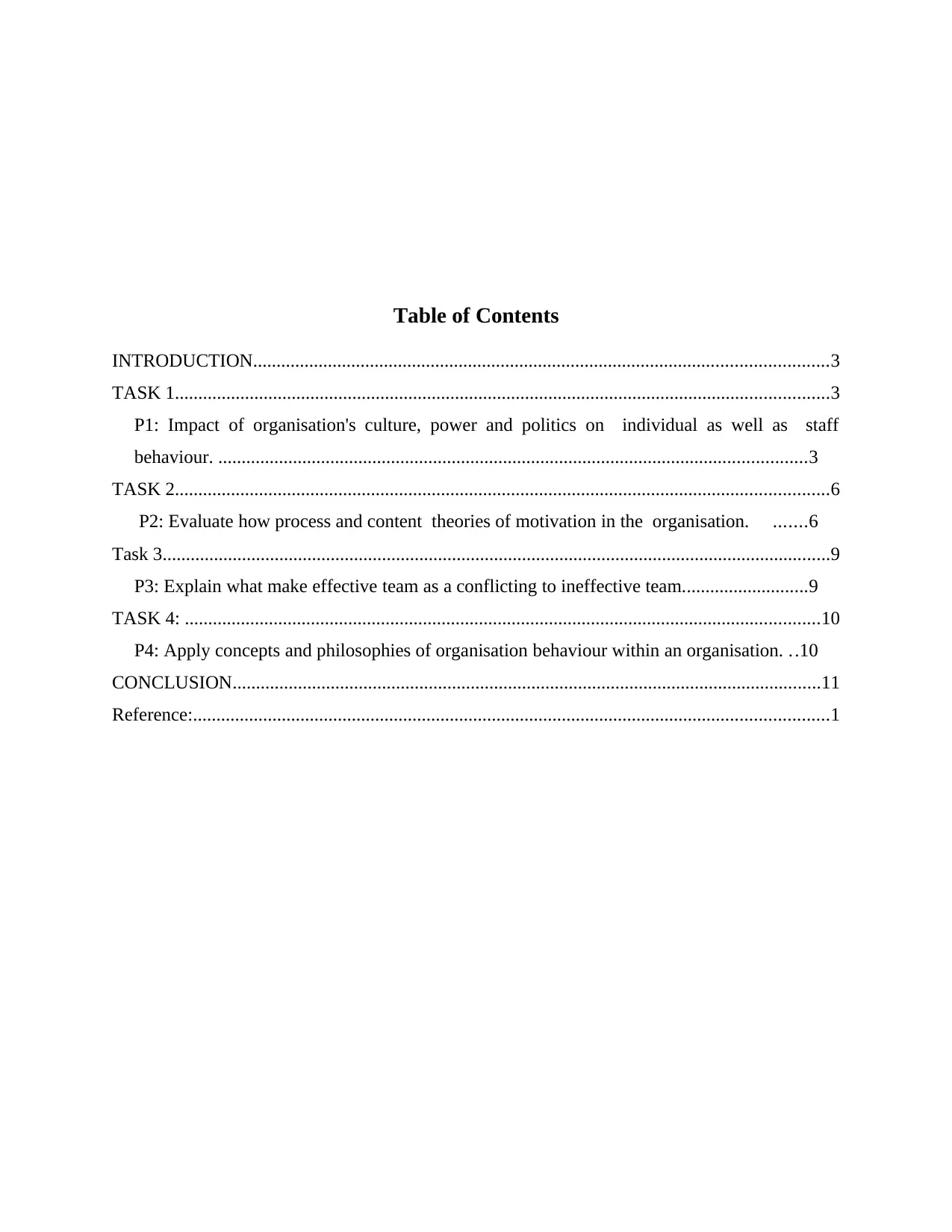
Table of Contents
INTRODUCTION...........................................................................................................................3
TASK 1............................................................................................................................................3
P1: Impact of organisation's culture, power and politics on individual as well as staff
behaviour. ..............................................................................................................................3
TASK 2............................................................................................................................................6
P2: Evaluate how process and content theories of motivation in the organisation. .......6
Task 3...............................................................................................................................................9
P3: Explain what make effective team as a conflicting to ineffective team...........................9
TASK 4: ........................................................................................................................................10
P4: Apply concepts and philosophies of organisation behaviour within an organisation. ..10
CONCLUSION..............................................................................................................................11
Reference:........................................................................................................................................1
INTRODUCTION...........................................................................................................................3
TASK 1............................................................................................................................................3
P1: Impact of organisation's culture, power and politics on individual as well as staff
behaviour. ..............................................................................................................................3
TASK 2............................................................................................................................................6
P2: Evaluate how process and content theories of motivation in the organisation. .......6
Task 3...............................................................................................................................................9
P3: Explain what make effective team as a conflicting to ineffective team...........................9
TASK 4: ........................................................................................................................................10
P4: Apply concepts and philosophies of organisation behaviour within an organisation. ..10
CONCLUSION..............................................................................................................................11
Reference:........................................................................................................................................1
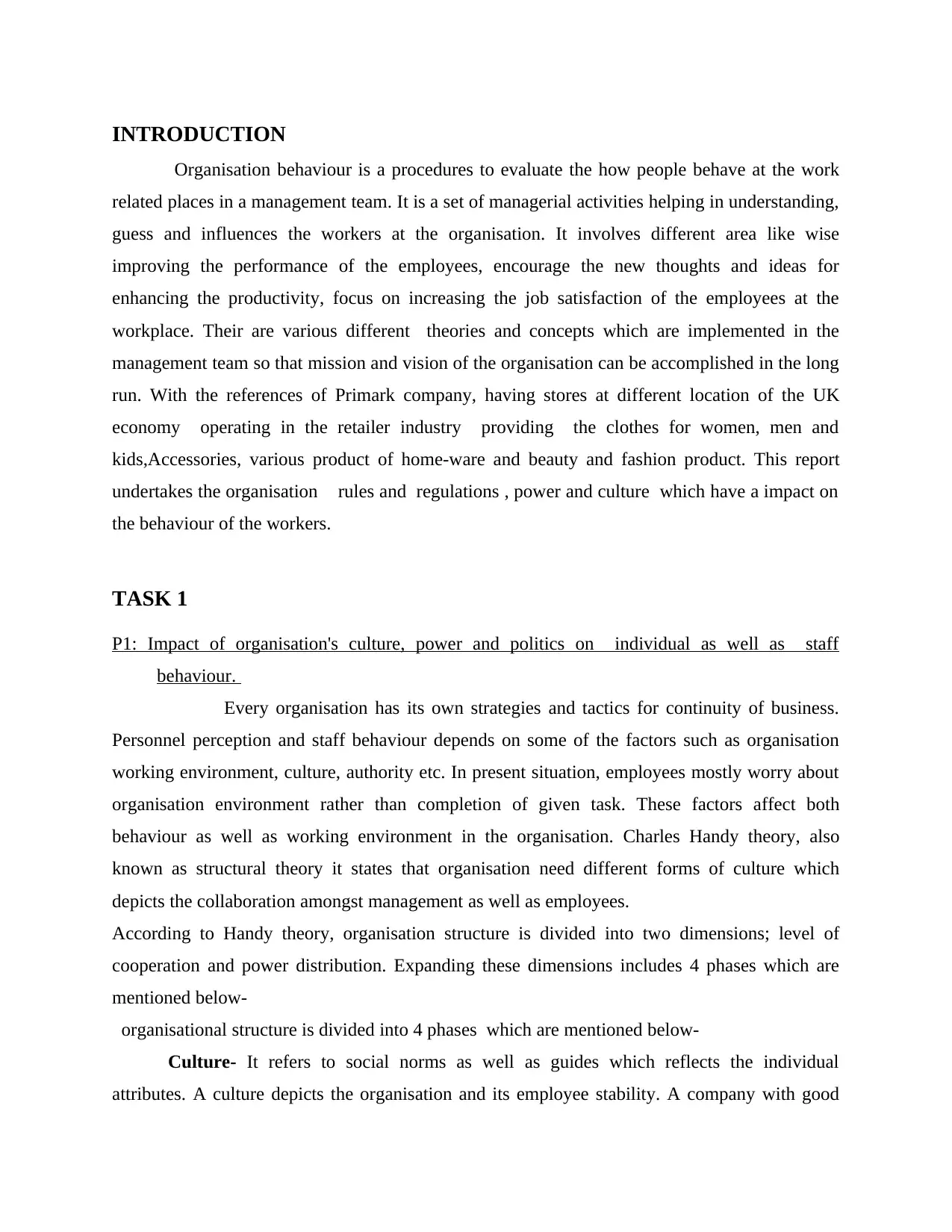
INTRODUCTION
Organisation behaviour is a procedures to evaluate the how people behave at the work
related places in a management team. It is a set of managerial activities helping in understanding,
guess and influences the workers at the organisation. It involves different area like wise
improving the performance of the employees, encourage the new thoughts and ideas for
enhancing the productivity, focus on increasing the job satisfaction of the employees at the
workplace. Their are various different theories and concepts which are implemented in the
management team so that mission and vision of the organisation can be accomplished in the long
run. With the references of Primark company, having stores at different location of the UK
economy operating in the retailer industry providing the clothes for women, men and
kids,Accessories, various product of home-ware and beauty and fashion product. This report
undertakes the organisation rules and regulations , power and culture which have a impact on
the behaviour of the workers.
TASK 1
P1: Impact of organisation's culture, power and politics on individual as well as staff
behaviour.
Every organisation has its own strategies and tactics for continuity of business.
Personnel perception and staff behaviour depends on some of the factors such as organisation
working environment, culture, authority etc. In present situation, employees mostly worry about
organisation environment rather than completion of given task. These factors affect both
behaviour as well as working environment in the organisation. Charles Handy theory, also
known as structural theory it states that organisation need different forms of culture which
depicts the collaboration amongst management as well as employees.
According to Handy theory, organisation structure is divided into two dimensions; level of
cooperation and power distribution. Expanding these dimensions includes 4 phases which are
mentioned below-
organisational structure is divided into 4 phases which are mentioned below-
Culture- It refers to social norms as well as guides which reflects the individual
attributes. A culture depicts the organisation and its employee stability. A company with good
Organisation behaviour is a procedures to evaluate the how people behave at the work
related places in a management team. It is a set of managerial activities helping in understanding,
guess and influences the workers at the organisation. It involves different area like wise
improving the performance of the employees, encourage the new thoughts and ideas for
enhancing the productivity, focus on increasing the job satisfaction of the employees at the
workplace. Their are various different theories and concepts which are implemented in the
management team so that mission and vision of the organisation can be accomplished in the long
run. With the references of Primark company, having stores at different location of the UK
economy operating in the retailer industry providing the clothes for women, men and
kids,Accessories, various product of home-ware and beauty and fashion product. This report
undertakes the organisation rules and regulations , power and culture which have a impact on
the behaviour of the workers.
TASK 1
P1: Impact of organisation's culture, power and politics on individual as well as staff
behaviour.
Every organisation has its own strategies and tactics for continuity of business.
Personnel perception and staff behaviour depends on some of the factors such as organisation
working environment, culture, authority etc. In present situation, employees mostly worry about
organisation environment rather than completion of given task. These factors affect both
behaviour as well as working environment in the organisation. Charles Handy theory, also
known as structural theory it states that organisation need different forms of culture which
depicts the collaboration amongst management as well as employees.
According to Handy theory, organisation structure is divided into two dimensions; level of
cooperation and power distribution. Expanding these dimensions includes 4 phases which are
mentioned below-
organisational structure is divided into 4 phases which are mentioned below-
Culture- It refers to social norms as well as guides which reflects the individual
attributes. A culture depicts the organisation and its employee stability. A company with good
⊘ This is a preview!⊘
Do you want full access?
Subscribe today to unlock all pages.

Trusted by 1+ million students worldwide
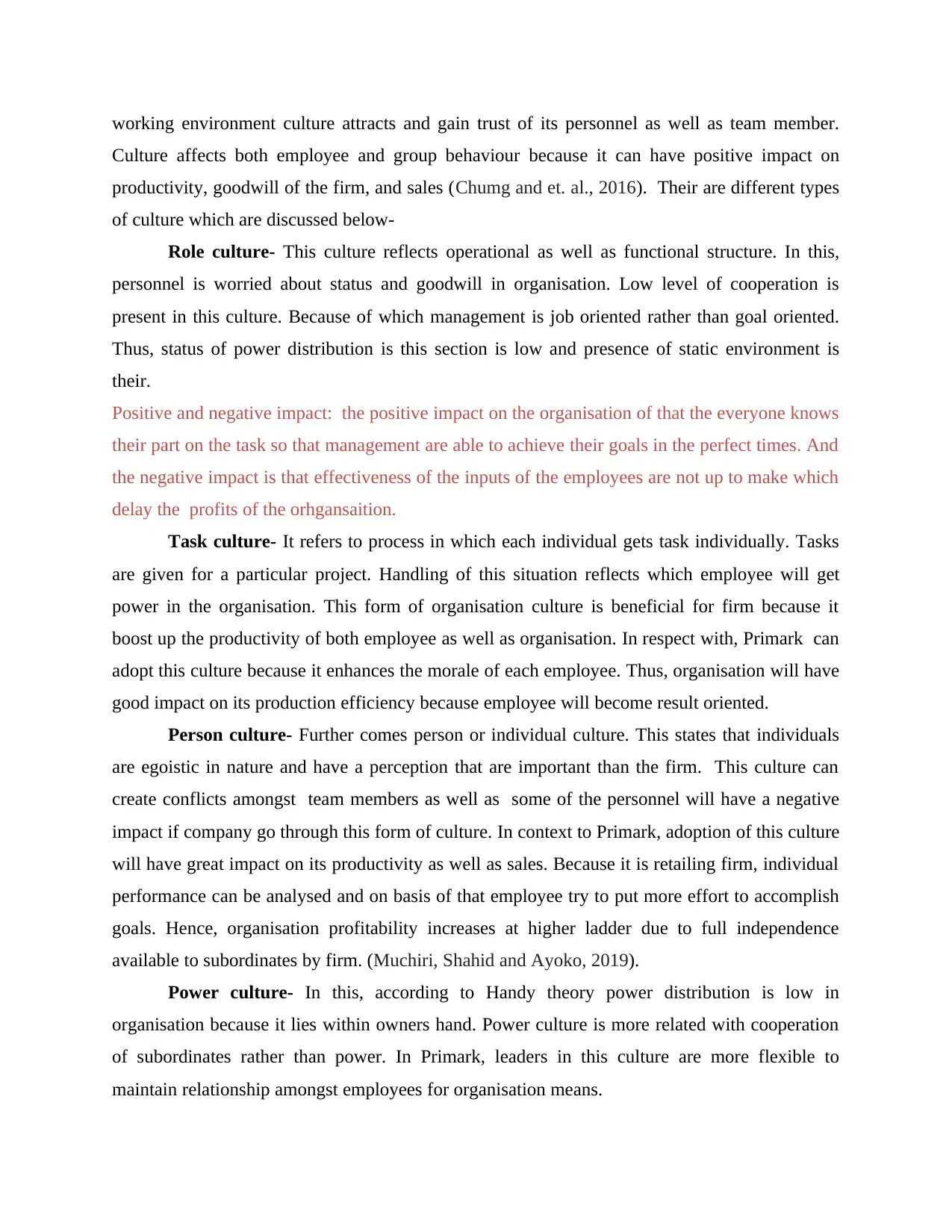
working environment culture attracts and gain trust of its personnel as well as team member.
Culture affects both employee and group behaviour because it can have positive impact on
productivity, goodwill of the firm, and sales (Chumg and et. al., 2016). Their are different types
of culture which are discussed below-
Role culture- This culture reflects operational as well as functional structure. In this,
personnel is worried about status and goodwill in organisation. Low level of cooperation is
present in this culture. Because of which management is job oriented rather than goal oriented.
Thus, status of power distribution is this section is low and presence of static environment is
their.
Positive and negative impact: the positive impact on the organisation of that the everyone knows
their part on the task so that management are able to achieve their goals in the perfect times. And
the negative impact is that effectiveness of the inputs of the employees are not up to make which
delay the profits of the orhgansaition.
Task culture- It refers to process in which each individual gets task individually. Tasks
are given for a particular project. Handling of this situation reflects which employee will get
power in the organisation. This form of organisation culture is beneficial for firm because it
boost up the productivity of both employee as well as organisation. In respect with, Primark can
adopt this culture because it enhances the morale of each employee. Thus, organisation will have
good impact on its production efficiency because employee will become result oriented.
Person culture- Further comes person or individual culture. This states that individuals
are egoistic in nature and have a perception that are important than the firm. This culture can
create conflicts amongst team members as well as some of the personnel will have a negative
impact if company go through this form of culture. In context to Primark, adoption of this culture
will have great impact on its productivity as well as sales. Because it is retailing firm, individual
performance can be analysed and on basis of that employee try to put more effort to accomplish
goals. Hence, organisation profitability increases at higher ladder due to full independence
available to subordinates by firm. (Muchiri, Shahid and Ayoko, 2019).
Power culture- In this, according to Handy theory power distribution is low in
organisation because it lies within owners hand. Power culture is more related with cooperation
of subordinates rather than power. In Primark, leaders in this culture are more flexible to
maintain relationship amongst employees for organisation means.
Culture affects both employee and group behaviour because it can have positive impact on
productivity, goodwill of the firm, and sales (Chumg and et. al., 2016). Their are different types
of culture which are discussed below-
Role culture- This culture reflects operational as well as functional structure. In this,
personnel is worried about status and goodwill in organisation. Low level of cooperation is
present in this culture. Because of which management is job oriented rather than goal oriented.
Thus, status of power distribution is this section is low and presence of static environment is
their.
Positive and negative impact: the positive impact on the organisation of that the everyone knows
their part on the task so that management are able to achieve their goals in the perfect times. And
the negative impact is that effectiveness of the inputs of the employees are not up to make which
delay the profits of the orhgansaition.
Task culture- It refers to process in which each individual gets task individually. Tasks
are given for a particular project. Handling of this situation reflects which employee will get
power in the organisation. This form of organisation culture is beneficial for firm because it
boost up the productivity of both employee as well as organisation. In respect with, Primark can
adopt this culture because it enhances the morale of each employee. Thus, organisation will have
good impact on its production efficiency because employee will become result oriented.
Person culture- Further comes person or individual culture. This states that individuals
are egoistic in nature and have a perception that are important than the firm. This culture can
create conflicts amongst team members as well as some of the personnel will have a negative
impact if company go through this form of culture. In context to Primark, adoption of this culture
will have great impact on its productivity as well as sales. Because it is retailing firm, individual
performance can be analysed and on basis of that employee try to put more effort to accomplish
goals. Hence, organisation profitability increases at higher ladder due to full independence
available to subordinates by firm. (Muchiri, Shahid and Ayoko, 2019).
Power culture- In this, according to Handy theory power distribution is low in
organisation because it lies within owners hand. Power culture is more related with cooperation
of subordinates rather than power. In Primark, leaders in this culture are more flexible to
maintain relationship amongst employees for organisation means.
Paraphrase This Document
Need a fresh take? Get an instant paraphrase of this document with our AI Paraphraser
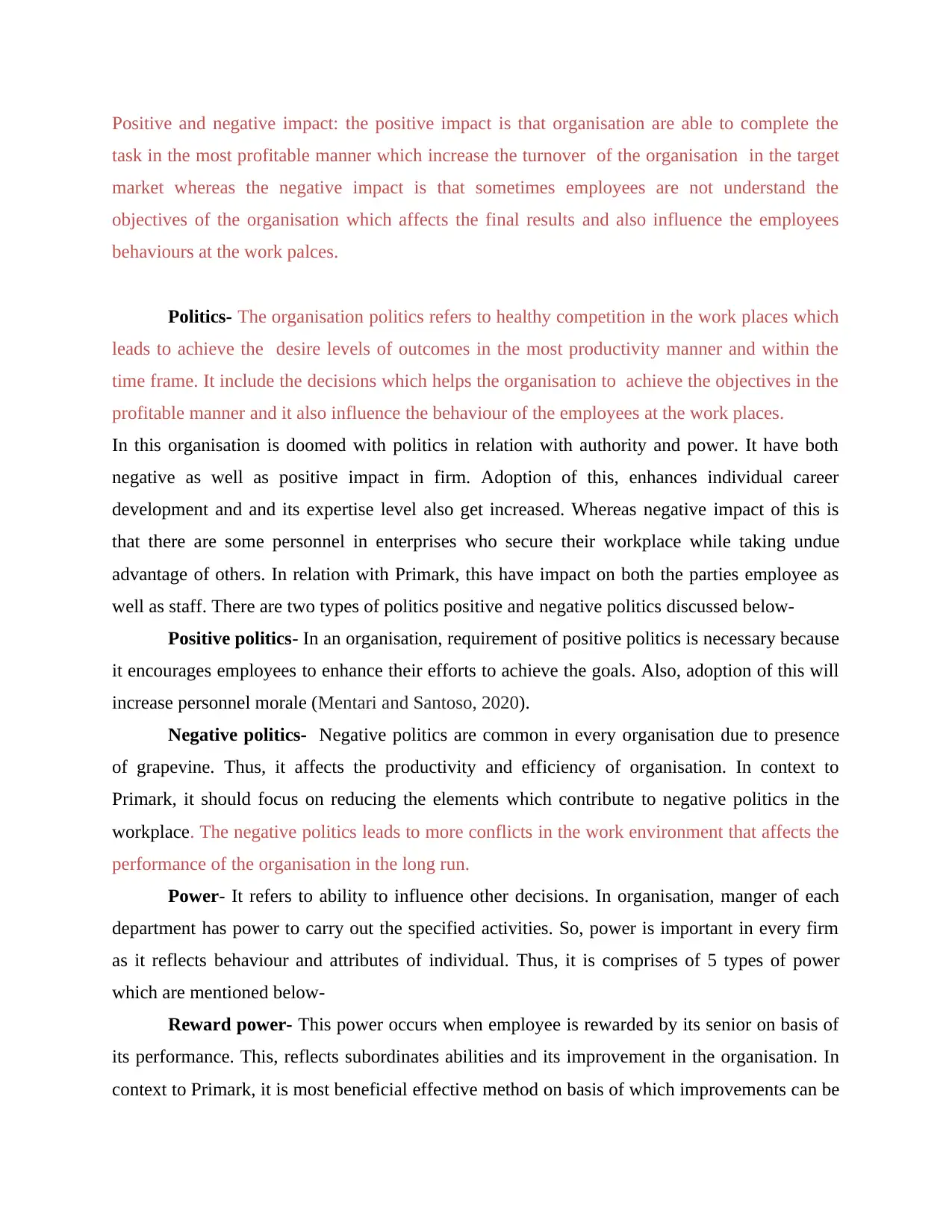
Positive and negative impact: the positive impact is that organisation are able to complete the
task in the most profitable manner which increase the turnover of the organisation in the target
market whereas the negative impact is that sometimes employees are not understand the
objectives of the organisation which affects the final results and also influence the employees
behaviours at the work palces.
Politics- The organisation politics refers to healthy competition in the work places which
leads to achieve the desire levels of outcomes in the most productivity manner and within the
time frame. It include the decisions which helps the organisation to achieve the objectives in the
profitable manner and it also influence the behaviour of the employees at the work places.
In this organisation is doomed with politics in relation with authority and power. It have both
negative as well as positive impact in firm. Adoption of this, enhances individual career
development and and its expertise level also get increased. Whereas negative impact of this is
that there are some personnel in enterprises who secure their workplace while taking undue
advantage of others. In relation with Primark, this have impact on both the parties employee as
well as staff. There are two types of politics positive and negative politics discussed below-
Positive politics- In an organisation, requirement of positive politics is necessary because
it encourages employees to enhance their efforts to achieve the goals. Also, adoption of this will
increase personnel morale (Mentari and Santoso, 2020).
Negative politics- Negative politics are common in every organisation due to presence
of grapevine. Thus, it affects the productivity and efficiency of organisation. In context to
Primark, it should focus on reducing the elements which contribute to negative politics in the
workplace. The negative politics leads to more conflicts in the work environment that affects the
performance of the organisation in the long run.
Power- It refers to ability to influence other decisions. In organisation, manger of each
department has power to carry out the specified activities. So, power is important in every firm
as it reflects behaviour and attributes of individual. Thus, it is comprises of 5 types of power
which are mentioned below-
Reward power- This power occurs when employee is rewarded by its senior on basis of
its performance. This, reflects subordinates abilities and its improvement in the organisation. In
context to Primark, it is most beneficial effective method on basis of which improvements can be
task in the most profitable manner which increase the turnover of the organisation in the target
market whereas the negative impact is that sometimes employees are not understand the
objectives of the organisation which affects the final results and also influence the employees
behaviours at the work palces.
Politics- The organisation politics refers to healthy competition in the work places which
leads to achieve the desire levels of outcomes in the most productivity manner and within the
time frame. It include the decisions which helps the organisation to achieve the objectives in the
profitable manner and it also influence the behaviour of the employees at the work places.
In this organisation is doomed with politics in relation with authority and power. It have both
negative as well as positive impact in firm. Adoption of this, enhances individual career
development and and its expertise level also get increased. Whereas negative impact of this is
that there are some personnel in enterprises who secure their workplace while taking undue
advantage of others. In relation with Primark, this have impact on both the parties employee as
well as staff. There are two types of politics positive and negative politics discussed below-
Positive politics- In an organisation, requirement of positive politics is necessary because
it encourages employees to enhance their efforts to achieve the goals. Also, adoption of this will
increase personnel morale (Mentari and Santoso, 2020).
Negative politics- Negative politics are common in every organisation due to presence
of grapevine. Thus, it affects the productivity and efficiency of organisation. In context to
Primark, it should focus on reducing the elements which contribute to negative politics in the
workplace. The negative politics leads to more conflicts in the work environment that affects the
performance of the organisation in the long run.
Power- It refers to ability to influence other decisions. In organisation, manger of each
department has power to carry out the specified activities. So, power is important in every firm
as it reflects behaviour and attributes of individual. Thus, it is comprises of 5 types of power
which are mentioned below-
Reward power- This power occurs when employee is rewarded by its senior on basis of
its performance. This, reflects subordinates abilities and its improvement in the organisation. In
context to Primark, it is most beneficial effective method on basis of which improvements can be
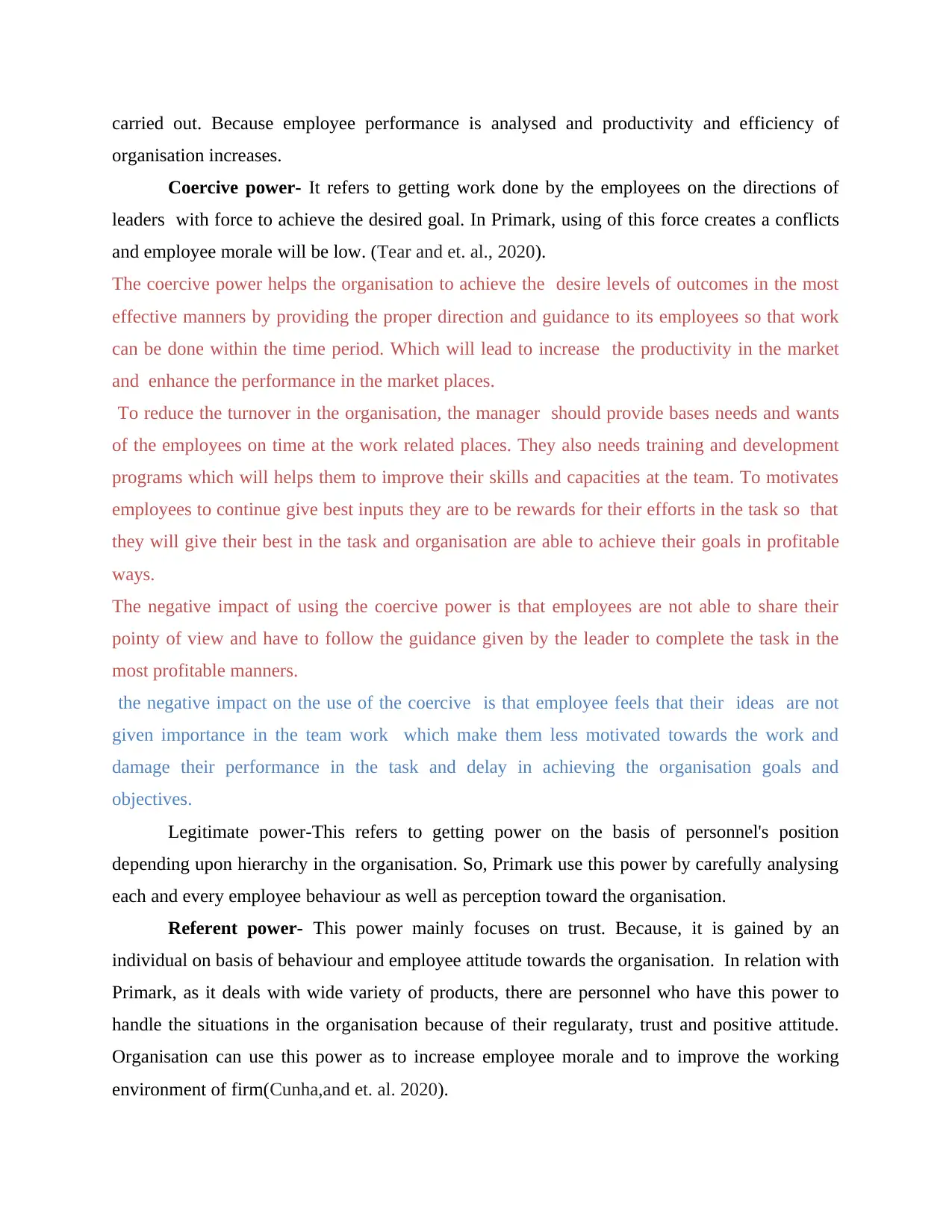
carried out. Because employee performance is analysed and productivity and efficiency of
organisation increases.
Coercive power- It refers to getting work done by the employees on the directions of
leaders with force to achieve the desired goal. In Primark, using of this force creates a conflicts
and employee morale will be low. (Tear and et. al., 2020).
The coercive power helps the organisation to achieve the desire levels of outcomes in the most
effective manners by providing the proper direction and guidance to its employees so that work
can be done within the time period. Which will lead to increase the productivity in the market
and enhance the performance in the market places.
To reduce the turnover in the organisation, the manager should provide bases needs and wants
of the employees on time at the work related places. They also needs training and development
programs which will helps them to improve their skills and capacities at the team. To motivates
employees to continue give best inputs they are to be rewards for their efforts in the task so that
they will give their best in the task and organisation are able to achieve their goals in profitable
ways.
The negative impact of using the coercive power is that employees are not able to share their
pointy of view and have to follow the guidance given by the leader to complete the task in the
most profitable manners.
the negative impact on the use of the coercive is that employee feels that their ideas are not
given importance in the team work which make them less motivated towards the work and
damage their performance in the task and delay in achieving the organisation goals and
objectives.
Legitimate power-This refers to getting power on the basis of personnel's position
depending upon hierarchy in the organisation. So, Primark use this power by carefully analysing
each and every employee behaviour as well as perception toward the organisation.
Referent power- This power mainly focuses on trust. Because, it is gained by an
individual on basis of behaviour and employee attitude towards the organisation. In relation with
Primark, as it deals with wide variety of products, there are personnel who have this power to
handle the situations in the organisation because of their regularaty, trust and positive attitude.
Organisation can use this power as to increase employee morale and to improve the working
environment of firm(Cunha,and et. al. 2020).
organisation increases.
Coercive power- It refers to getting work done by the employees on the directions of
leaders with force to achieve the desired goal. In Primark, using of this force creates a conflicts
and employee morale will be low. (Tear and et. al., 2020).
The coercive power helps the organisation to achieve the desire levels of outcomes in the most
effective manners by providing the proper direction and guidance to its employees so that work
can be done within the time period. Which will lead to increase the productivity in the market
and enhance the performance in the market places.
To reduce the turnover in the organisation, the manager should provide bases needs and wants
of the employees on time at the work related places. They also needs training and development
programs which will helps them to improve their skills and capacities at the team. To motivates
employees to continue give best inputs they are to be rewards for their efforts in the task so that
they will give their best in the task and organisation are able to achieve their goals in profitable
ways.
The negative impact of using the coercive power is that employees are not able to share their
pointy of view and have to follow the guidance given by the leader to complete the task in the
most profitable manners.
the negative impact on the use of the coercive is that employee feels that their ideas are not
given importance in the team work which make them less motivated towards the work and
damage their performance in the task and delay in achieving the organisation goals and
objectives.
Legitimate power-This refers to getting power on the basis of personnel's position
depending upon hierarchy in the organisation. So, Primark use this power by carefully analysing
each and every employee behaviour as well as perception toward the organisation.
Referent power- This power mainly focuses on trust. Because, it is gained by an
individual on basis of behaviour and employee attitude towards the organisation. In relation with
Primark, as it deals with wide variety of products, there are personnel who have this power to
handle the situations in the organisation because of their regularaty, trust and positive attitude.
Organisation can use this power as to increase employee morale and to improve the working
environment of firm(Cunha,and et. al. 2020).
⊘ This is a preview!⊘
Do you want full access?
Subscribe today to unlock all pages.

Trusted by 1+ million students worldwide
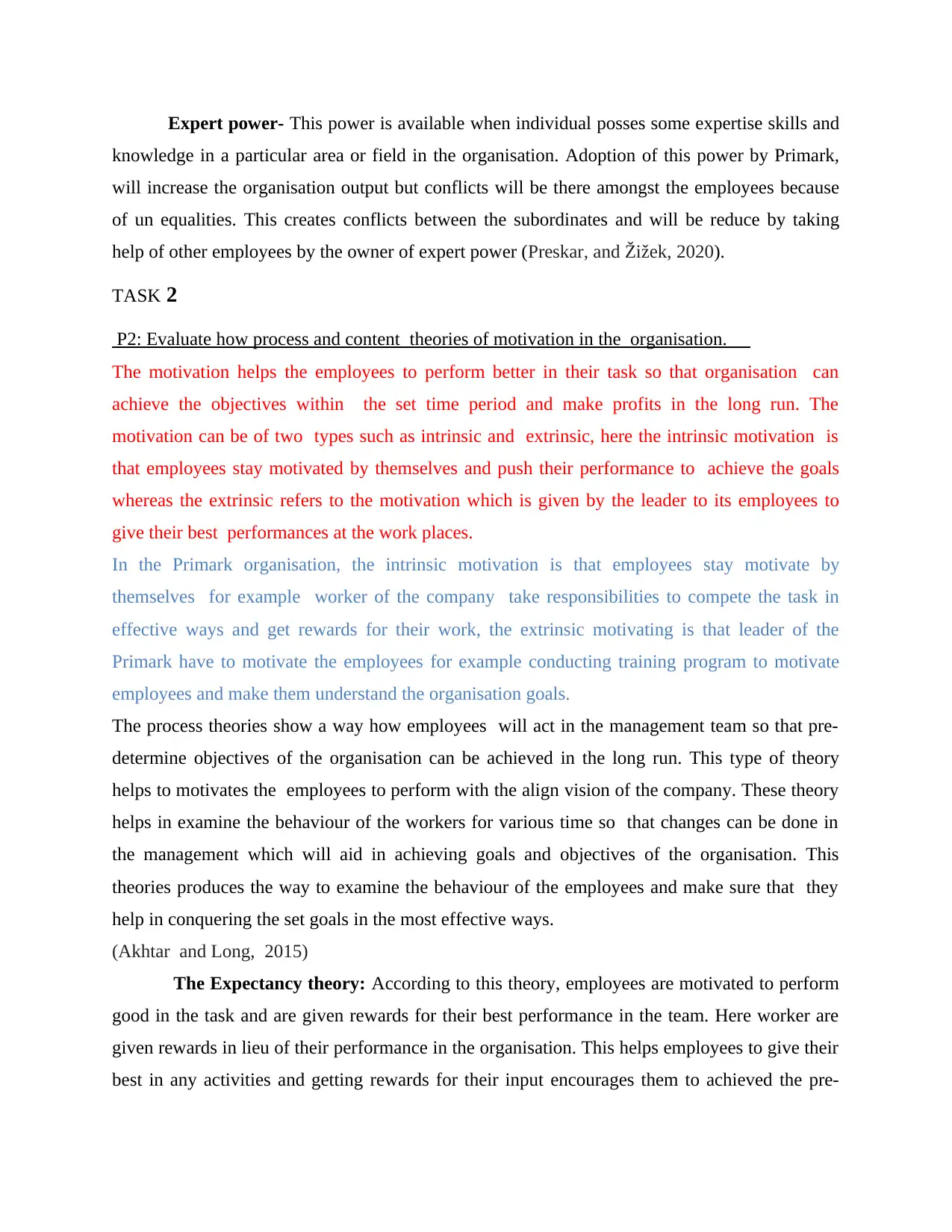
Expert power- This power is available when individual posses some expertise skills and
knowledge in a particular area or field in the organisation. Adoption of this power by Primark,
will increase the organisation output but conflicts will be there amongst the employees because
of un equalities. This creates conflicts between the subordinates and will be reduce by taking
help of other employees by the owner of expert power (Preskar, and Žižek, 2020).
TASK 2
P2: Evaluate how process and content theories of motivation in the organisation.
The motivation helps the employees to perform better in their task so that organisation can
achieve the objectives within the set time period and make profits in the long run. The
motivation can be of two types such as intrinsic and extrinsic, here the intrinsic motivation is
that employees stay motivated by themselves and push their performance to achieve the goals
whereas the extrinsic refers to the motivation which is given by the leader to its employees to
give their best performances at the work places.
In the Primark organisation, the intrinsic motivation is that employees stay motivate by
themselves for example worker of the company take responsibilities to compete the task in
effective ways and get rewards for their work, the extrinsic motivating is that leader of the
Primark have to motivate the employees for example conducting training program to motivate
employees and make them understand the organisation goals.
The process theories show a way how employees will act in the management team so that pre-
determine objectives of the organisation can be achieved in the long run. This type of theory
helps to motivates the employees to perform with the align vision of the company. These theory
helps in examine the behaviour of the workers for various time so that changes can be done in
the management which will aid in achieving goals and objectives of the organisation. This
theories produces the way to examine the behaviour of the employees and make sure that they
help in conquering the set goals in the most effective ways.
(Akhtar and Long, 2015)
The Expectancy theory: According to this theory, employees are motivated to perform
good in the task and are given rewards for their best performance in the team. Here worker are
given rewards in lieu of their performance in the organisation. This helps employees to give their
best in any activities and getting rewards for their input encourages them to achieved the pre-
knowledge in a particular area or field in the organisation. Adoption of this power by Primark,
will increase the organisation output but conflicts will be there amongst the employees because
of un equalities. This creates conflicts between the subordinates and will be reduce by taking
help of other employees by the owner of expert power (Preskar, and Žižek, 2020).
TASK 2
P2: Evaluate how process and content theories of motivation in the organisation.
The motivation helps the employees to perform better in their task so that organisation can
achieve the objectives within the set time period and make profits in the long run. The
motivation can be of two types such as intrinsic and extrinsic, here the intrinsic motivation is
that employees stay motivated by themselves and push their performance to achieve the goals
whereas the extrinsic refers to the motivation which is given by the leader to its employees to
give their best performances at the work places.
In the Primark organisation, the intrinsic motivation is that employees stay motivate by
themselves for example worker of the company take responsibilities to compete the task in
effective ways and get rewards for their work, the extrinsic motivating is that leader of the
Primark have to motivate the employees for example conducting training program to motivate
employees and make them understand the organisation goals.
The process theories show a way how employees will act in the management team so that pre-
determine objectives of the organisation can be achieved in the long run. This type of theory
helps to motivates the employees to perform with the align vision of the company. These theory
helps in examine the behaviour of the workers for various time so that changes can be done in
the management which will aid in achieving goals and objectives of the organisation. This
theories produces the way to examine the behaviour of the employees and make sure that they
help in conquering the set goals in the most effective ways.
(Akhtar and Long, 2015)
The Expectancy theory: According to this theory, employees are motivated to perform
good in the task and are given rewards for their best performance in the team. Here worker are
given rewards in lieu of their performance in the organisation. This helps employees to give their
best in any activities and getting rewards for their input encourages them to achieved the pre-
Paraphrase This Document
Need a fresh take? Get an instant paraphrase of this document with our AI Paraphraser
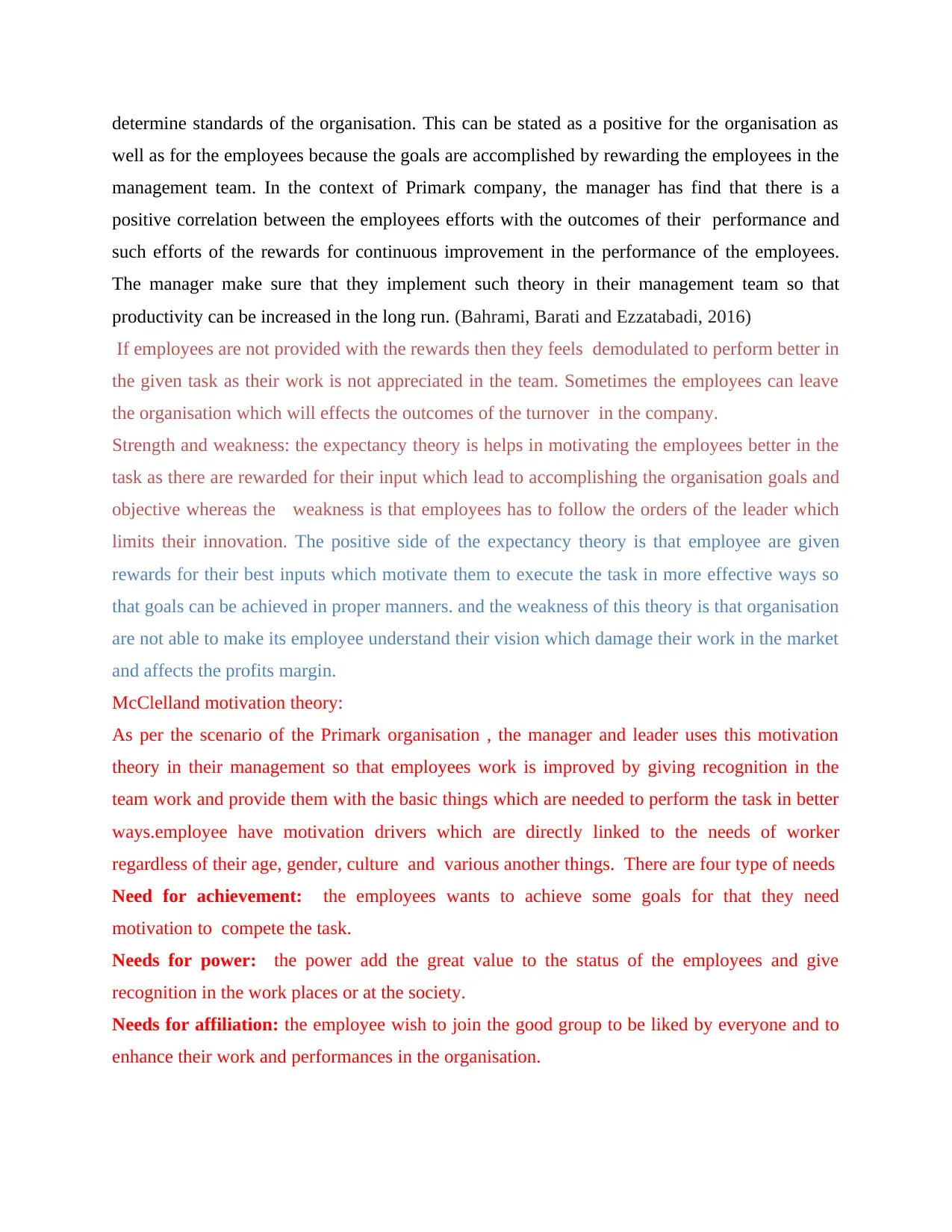
determine standards of the organisation. This can be stated as a positive for the organisation as
well as for the employees because the goals are accomplished by rewarding the employees in the
management team. In the context of Primark company, the manager has find that there is a
positive correlation between the employees efforts with the outcomes of their performance and
such efforts of the rewards for continuous improvement in the performance of the employees.
The manager make sure that they implement such theory in their management team so that
productivity can be increased in the long run. (Bahrami, Barati and Ezzatabadi, 2016)
If employees are not provided with the rewards then they feels demodulated to perform better in
the given task as their work is not appreciated in the team. Sometimes the employees can leave
the organisation which will effects the outcomes of the turnover in the company.
Strength and weakness: the expectancy theory is helps in motivating the employees better in the
task as there are rewarded for their input which lead to accomplishing the organisation goals and
objective whereas the weakness is that employees has to follow the orders of the leader which
limits their innovation. The positive side of the expectancy theory is that employee are given
rewards for their best inputs which motivate them to execute the task in more effective ways so
that goals can be achieved in proper manners. and the weakness of this theory is that organisation
are not able to make its employee understand their vision which damage their work in the market
and affects the profits margin.
McClelland motivation theory:
As per the scenario of the Primark organisation , the manager and leader uses this motivation
theory in their management so that employees work is improved by giving recognition in the
team work and provide them with the basic things which are needed to perform the task in better
ways.employee have motivation drivers which are directly linked to the needs of worker
regardless of their age, gender, culture and various another things. There are four type of needs
Need for achievement: the employees wants to achieve some goals for that they need
motivation to compete the task.
Needs for power: the power add the great value to the status of the employees and give
recognition in the work places or at the society.
Needs for affiliation: the employee wish to join the good group to be liked by everyone and to
enhance their work and performances in the organisation.
well as for the employees because the goals are accomplished by rewarding the employees in the
management team. In the context of Primark company, the manager has find that there is a
positive correlation between the employees efforts with the outcomes of their performance and
such efforts of the rewards for continuous improvement in the performance of the employees.
The manager make sure that they implement such theory in their management team so that
productivity can be increased in the long run. (Bahrami, Barati and Ezzatabadi, 2016)
If employees are not provided with the rewards then they feels demodulated to perform better in
the given task as their work is not appreciated in the team. Sometimes the employees can leave
the organisation which will effects the outcomes of the turnover in the company.
Strength and weakness: the expectancy theory is helps in motivating the employees better in the
task as there are rewarded for their input which lead to accomplishing the organisation goals and
objective whereas the weakness is that employees has to follow the orders of the leader which
limits their innovation. The positive side of the expectancy theory is that employee are given
rewards for their best inputs which motivate them to execute the task in more effective ways so
that goals can be achieved in proper manners. and the weakness of this theory is that organisation
are not able to make its employee understand their vision which damage their work in the market
and affects the profits margin.
McClelland motivation theory:
As per the scenario of the Primark organisation , the manager and leader uses this motivation
theory in their management so that employees work is improved by giving recognition in the
team work and provide them with the basic things which are needed to perform the task in better
ways.employee have motivation drivers which are directly linked to the needs of worker
regardless of their age, gender, culture and various another things. There are four type of needs
Need for achievement: the employees wants to achieve some goals for that they need
motivation to compete the task.
Needs for power: the power add the great value to the status of the employees and give
recognition in the work places or at the society.
Needs for affiliation: the employee wish to join the good group to be liked by everyone and to
enhance their work and performances in the organisation.
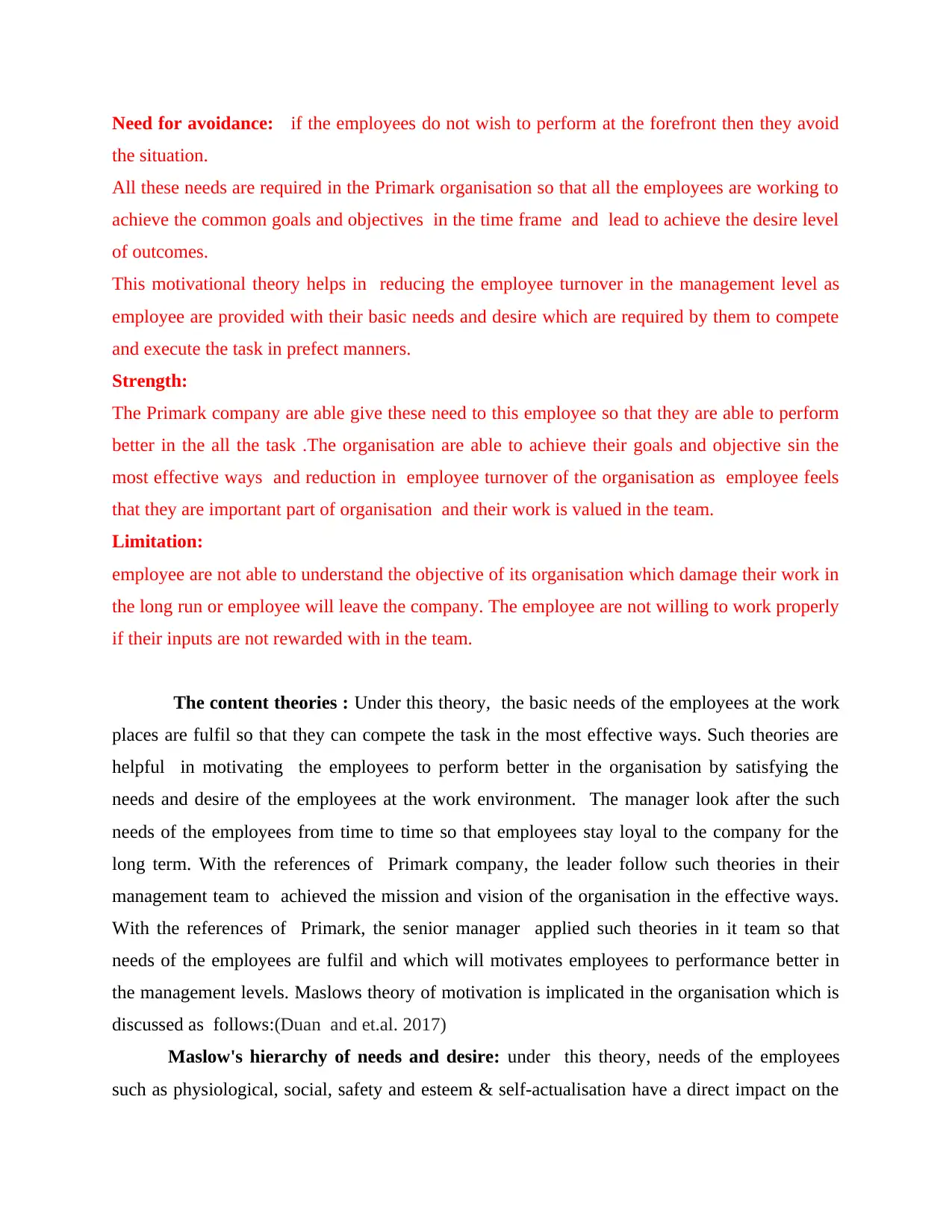
Need for avoidance: if the employees do not wish to perform at the forefront then they avoid
the situation.
All these needs are required in the Primark organisation so that all the employees are working to
achieve the common goals and objectives in the time frame and lead to achieve the desire level
of outcomes.
This motivational theory helps in reducing the employee turnover in the management level as
employee are provided with their basic needs and desire which are required by them to compete
and execute the task in prefect manners.
Strength:
The Primark company are able give these need to this employee so that they are able to perform
better in the all the task .The organisation are able to achieve their goals and objective sin the
most effective ways and reduction in employee turnover of the organisation as employee feels
that they are important part of organisation and their work is valued in the team.
Limitation:
employee are not able to understand the objective of its organisation which damage their work in
the long run or employee will leave the company. The employee are not willing to work properly
if their inputs are not rewarded with in the team.
The content theories : Under this theory, the basic needs of the employees at the work
places are fulfil so that they can compete the task in the most effective ways. Such theories are
helpful in motivating the employees to perform better in the organisation by satisfying the
needs and desire of the employees at the work environment. The manager look after the such
needs of the employees from time to time so that employees stay loyal to the company for the
long term. With the references of Primark company, the leader follow such theories in their
management team to achieved the mission and vision of the organisation in the effective ways.
With the references of Primark, the senior manager applied such theories in it team so that
needs of the employees are fulfil and which will motivates employees to performance better in
the management levels. Maslows theory of motivation is implicated in the organisation which is
discussed as follows:(Duan and et.al. 2017)
Maslow's hierarchy of needs and desire: under this theory, needs of the employees
such as physiological, social, safety and esteem & self-actualisation have a direct impact on the
the situation.
All these needs are required in the Primark organisation so that all the employees are working to
achieve the common goals and objectives in the time frame and lead to achieve the desire level
of outcomes.
This motivational theory helps in reducing the employee turnover in the management level as
employee are provided with their basic needs and desire which are required by them to compete
and execute the task in prefect manners.
Strength:
The Primark company are able give these need to this employee so that they are able to perform
better in the all the task .The organisation are able to achieve their goals and objective sin the
most effective ways and reduction in employee turnover of the organisation as employee feels
that they are important part of organisation and their work is valued in the team.
Limitation:
employee are not able to understand the objective of its organisation which damage their work in
the long run or employee will leave the company. The employee are not willing to work properly
if their inputs are not rewarded with in the team.
The content theories : Under this theory, the basic needs of the employees at the work
places are fulfil so that they can compete the task in the most effective ways. Such theories are
helpful in motivating the employees to perform better in the organisation by satisfying the
needs and desire of the employees at the work environment. The manager look after the such
needs of the employees from time to time so that employees stay loyal to the company for the
long term. With the references of Primark company, the leader follow such theories in their
management team to achieved the mission and vision of the organisation in the effective ways.
With the references of Primark, the senior manager applied such theories in it team so that
needs of the employees are fulfil and which will motivates employees to performance better in
the management levels. Maslows theory of motivation is implicated in the organisation which is
discussed as follows:(Duan and et.al. 2017)
Maslow's hierarchy of needs and desire: under this theory, needs of the employees
such as physiological, social, safety and esteem & self-actualisation have a direct impact on the
⊘ This is a preview!⊘
Do you want full access?
Subscribe today to unlock all pages.

Trusted by 1+ million students worldwide
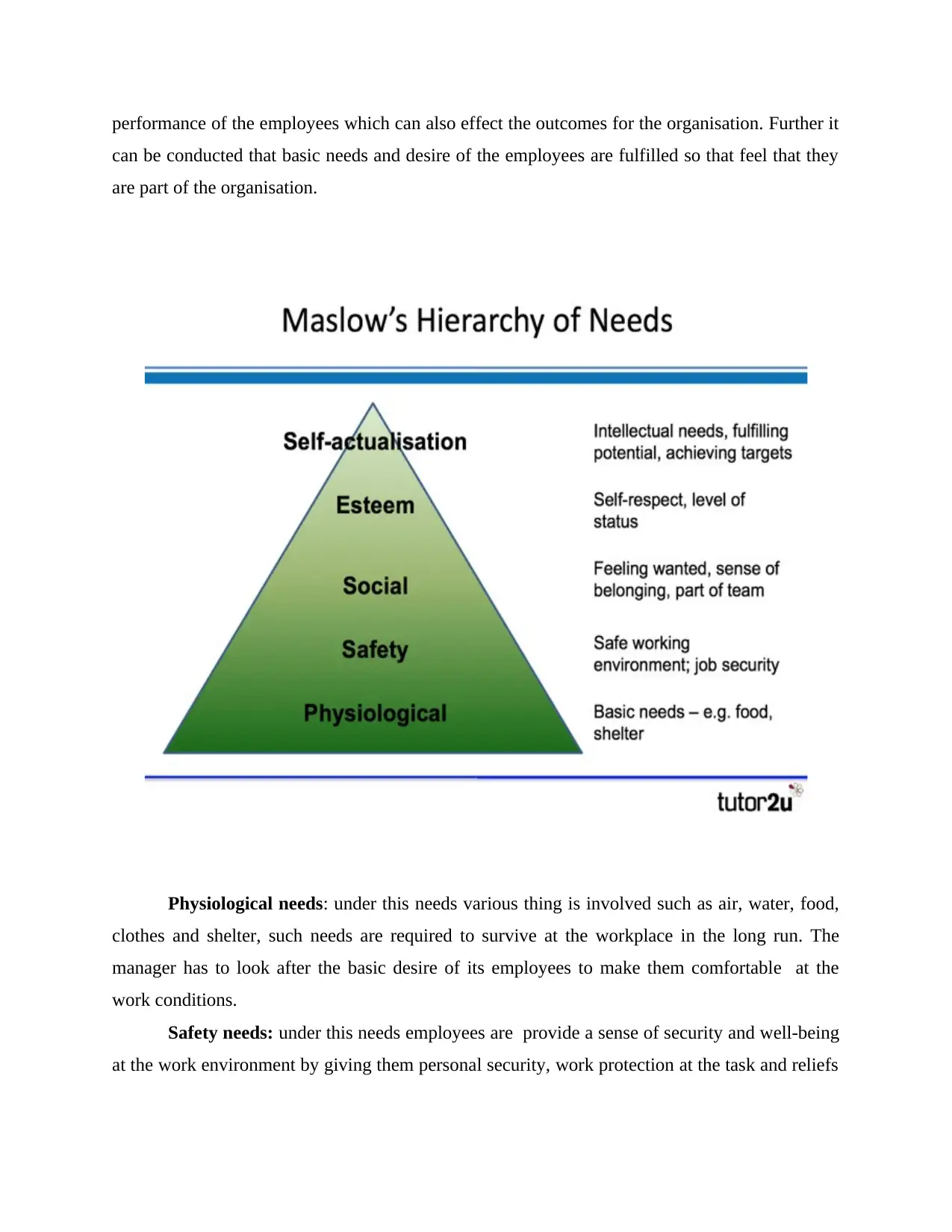
performance of the employees which can also effect the outcomes for the organisation. Further it
can be conducted that basic needs and desire of the employees are fulfilled so that feel that they
are part of the organisation.
Physiological needs: under this needs various thing is involved such as air, water, food,
clothes and shelter, such needs are required to survive at the workplace in the long run. The
manager has to look after the basic desire of its employees to make them comfortable at the
work conditions.
Safety needs: under this needs employees are provide a sense of security and well-being
at the work environment by giving them personal security, work protection at the task and reliefs
can be conducted that basic needs and desire of the employees are fulfilled so that feel that they
are part of the organisation.
Physiological needs: under this needs various thing is involved such as air, water, food,
clothes and shelter, such needs are required to survive at the workplace in the long run. The
manager has to look after the basic desire of its employees to make them comfortable at the
work conditions.
Safety needs: under this needs employees are provide a sense of security and well-being
at the work environment by giving them personal security, work protection at the task and reliefs
Paraphrase This Document
Need a fresh take? Get an instant paraphrase of this document with our AI Paraphraser
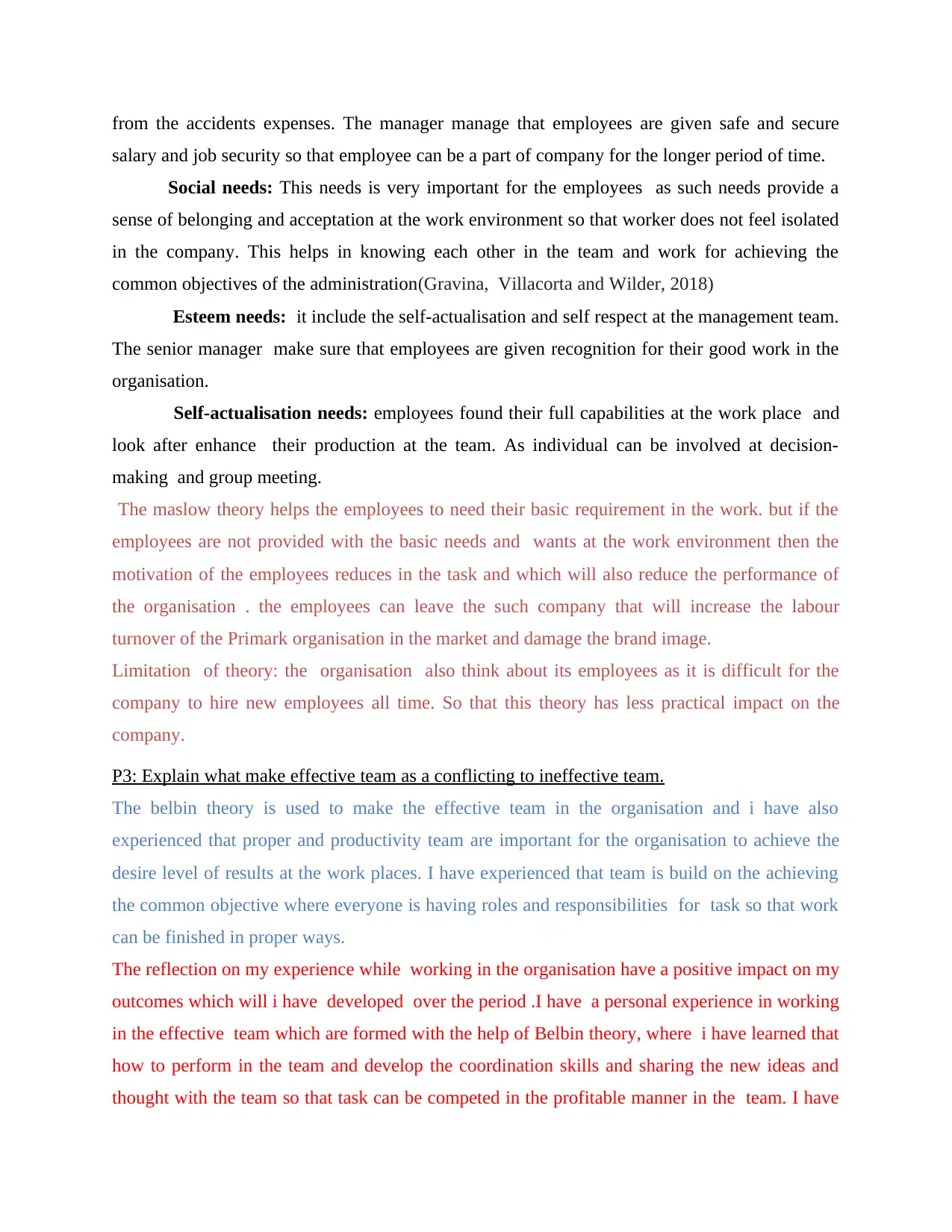
from the accidents expenses. The manager manage that employees are given safe and secure
salary and job security so that employee can be a part of company for the longer period of time.
Social needs: This needs is very important for the employees as such needs provide a
sense of belonging and acceptation at the work environment so that worker does not feel isolated
in the company. This helps in knowing each other in the team and work for achieving the
common objectives of the administration(Gravina, Villacorta and Wilder, 2018)
Esteem needs: it include the self-actualisation and self respect at the management team.
The senior manager make sure that employees are given recognition for their good work in the
organisation.
Self-actualisation needs: employees found their full capabilities at the work place and
look after enhance their production at the team. As individual can be involved at decision-
making and group meeting.
The maslow theory helps the employees to need their basic requirement in the work. but if the
employees are not provided with the basic needs and wants at the work environment then the
motivation of the employees reduces in the task and which will also reduce the performance of
the organisation . the employees can leave the such company that will increase the labour
turnover of the Primark organisation in the market and damage the brand image.
Limitation of theory: the organisation also think about its employees as it is difficult for the
company to hire new employees all time. So that this theory has less practical impact on the
company.
P3: Explain what make effective team as a conflicting to ineffective team.
The belbin theory is used to make the effective team in the organisation and i have also
experienced that proper and productivity team are important for the organisation to achieve the
desire level of results at the work places. I have experienced that team is build on the achieving
the common objective where everyone is having roles and responsibilities for task so that work
can be finished in proper ways.
The reflection on my experience while working in the organisation have a positive impact on my
outcomes which will i have developed over the period .I have a personal experience in working
in the effective team which are formed with the help of Belbin theory, where i have learned that
how to perform in the team and develop the coordination skills and sharing the new ideas and
thought with the team so that task can be competed in the profitable manner in the team. I have
salary and job security so that employee can be a part of company for the longer period of time.
Social needs: This needs is very important for the employees as such needs provide a
sense of belonging and acceptation at the work environment so that worker does not feel isolated
in the company. This helps in knowing each other in the team and work for achieving the
common objectives of the administration(Gravina, Villacorta and Wilder, 2018)
Esteem needs: it include the self-actualisation and self respect at the management team.
The senior manager make sure that employees are given recognition for their good work in the
organisation.
Self-actualisation needs: employees found their full capabilities at the work place and
look after enhance their production at the team. As individual can be involved at decision-
making and group meeting.
The maslow theory helps the employees to need their basic requirement in the work. but if the
employees are not provided with the basic needs and wants at the work environment then the
motivation of the employees reduces in the task and which will also reduce the performance of
the organisation . the employees can leave the such company that will increase the labour
turnover of the Primark organisation in the market and damage the brand image.
Limitation of theory: the organisation also think about its employees as it is difficult for the
company to hire new employees all time. So that this theory has less practical impact on the
company.
P3: Explain what make effective team as a conflicting to ineffective team.
The belbin theory is used to make the effective team in the organisation and i have also
experienced that proper and productivity team are important for the organisation to achieve the
desire level of results at the work places. I have experienced that team is build on the achieving
the common objective where everyone is having roles and responsibilities for task so that work
can be finished in proper ways.
The reflection on my experience while working in the organisation have a positive impact on my
outcomes which will i have developed over the period .I have a personal experience in working
in the effective team which are formed with the help of Belbin theory, where i have learned that
how to perform in the team and develop the coordination skills and sharing the new ideas and
thought with the team so that task can be competed in the profitable manner in the team. I have
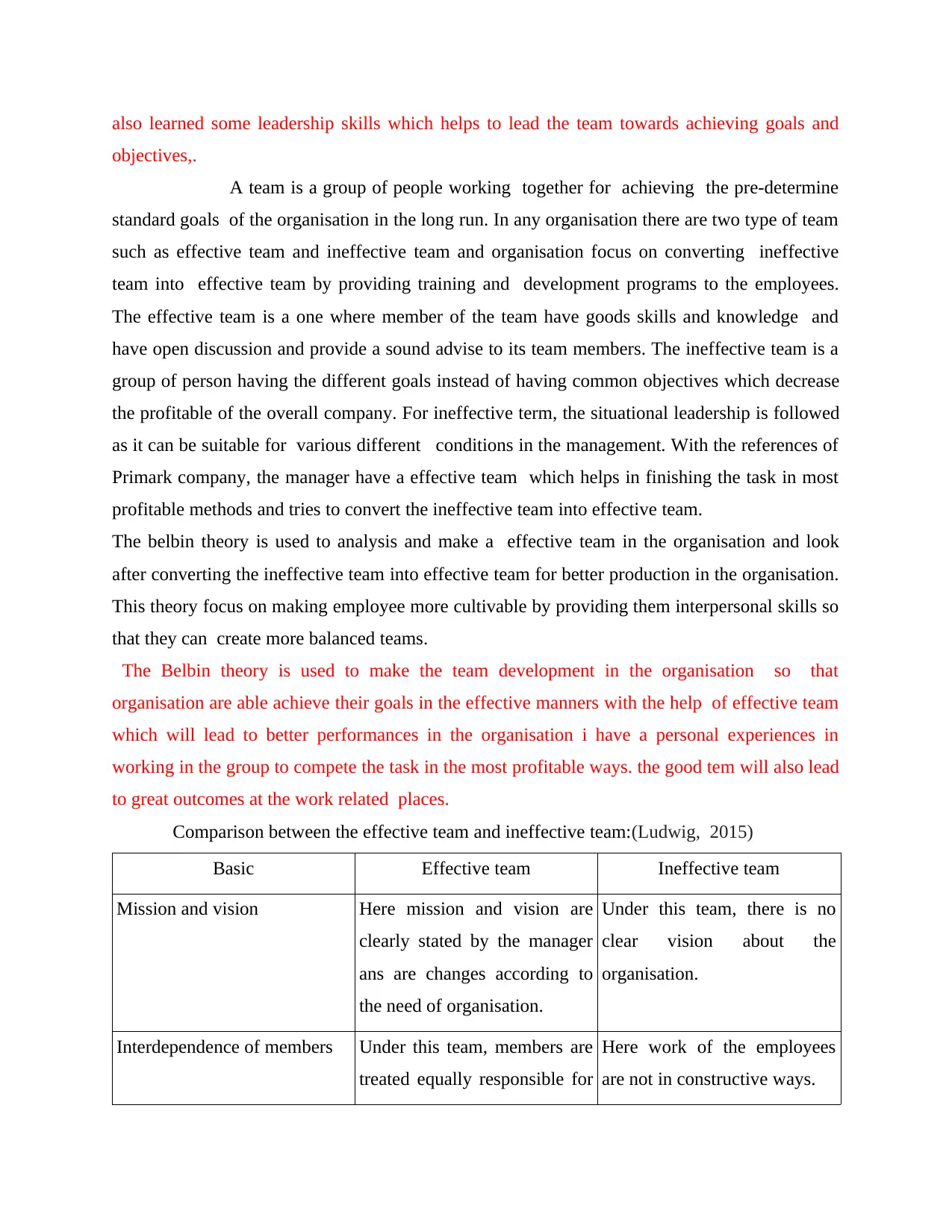
also learned some leadership skills which helps to lead the team towards achieving goals and
objectives,.
A team is a group of people working together for achieving the pre-determine
standard goals of the organisation in the long run. In any organisation there are two type of team
such as effective team and ineffective team and organisation focus on converting ineffective
team into effective team by providing training and development programs to the employees.
The effective team is a one where member of the team have goods skills and knowledge and
have open discussion and provide a sound advise to its team members. The ineffective team is a
group of person having the different goals instead of having common objectives which decrease
the profitable of the overall company. For ineffective term, the situational leadership is followed
as it can be suitable for various different conditions in the management. With the references of
Primark company, the manager have a effective team which helps in finishing the task in most
profitable methods and tries to convert the ineffective team into effective team.
The belbin theory is used to analysis and make a effective team in the organisation and look
after converting the ineffective team into effective team for better production in the organisation.
This theory focus on making employee more cultivable by providing them interpersonal skills so
that they can create more balanced teams.
The Belbin theory is used to make the team development in the organisation so that
organisation are able achieve their goals in the effective manners with the help of effective team
which will lead to better performances in the organisation i have a personal experiences in
working in the group to compete the task in the most profitable ways. the good tem will also lead
to great outcomes at the work related places.
Comparison between the effective team and ineffective team:(Ludwig, 2015)
Basic Effective team Ineffective team
Mission and vision Here mission and vision are
clearly stated by the manager
ans are changes according to
the need of organisation.
Under this team, there is no
clear vision about the
organisation.
Interdependence of members Under this team, members are
treated equally responsible for
Here work of the employees
are not in constructive ways.
objectives,.
A team is a group of people working together for achieving the pre-determine
standard goals of the organisation in the long run. In any organisation there are two type of team
such as effective team and ineffective team and organisation focus on converting ineffective
team into effective team by providing training and development programs to the employees.
The effective team is a one where member of the team have goods skills and knowledge and
have open discussion and provide a sound advise to its team members. The ineffective team is a
group of person having the different goals instead of having common objectives which decrease
the profitable of the overall company. For ineffective term, the situational leadership is followed
as it can be suitable for various different conditions in the management. With the references of
Primark company, the manager have a effective team which helps in finishing the task in most
profitable methods and tries to convert the ineffective team into effective team.
The belbin theory is used to analysis and make a effective team in the organisation and look
after converting the ineffective team into effective team for better production in the organisation.
This theory focus on making employee more cultivable by providing them interpersonal skills so
that they can create more balanced teams.
The Belbin theory is used to make the team development in the organisation so that
organisation are able achieve their goals in the effective manners with the help of effective team
which will lead to better performances in the organisation i have a personal experiences in
working in the group to compete the task in the most profitable ways. the good tem will also lead
to great outcomes at the work related places.
Comparison between the effective team and ineffective team:(Ludwig, 2015)
Basic Effective team Ineffective team
Mission and vision Here mission and vision are
clearly stated by the manager
ans are changes according to
the need of organisation.
Under this team, there is no
clear vision about the
organisation.
Interdependence of members Under this team, members are
treated equally responsible for
Here work of the employees
are not in constructive ways.
⊘ This is a preview!⊘
Do you want full access?
Subscribe today to unlock all pages.

Trusted by 1+ million students worldwide
1 out of 18
Related Documents
Your All-in-One AI-Powered Toolkit for Academic Success.
+13062052269
info@desklib.com
Available 24*7 on WhatsApp / Email
![[object Object]](/_next/static/media/star-bottom.7253800d.svg)
Unlock your academic potential
Copyright © 2020–2025 A2Z Services. All Rights Reserved. Developed and managed by ZUCOL.




